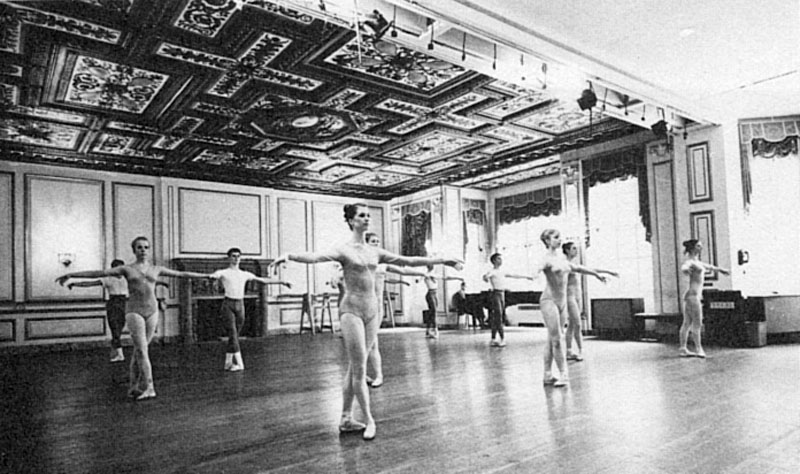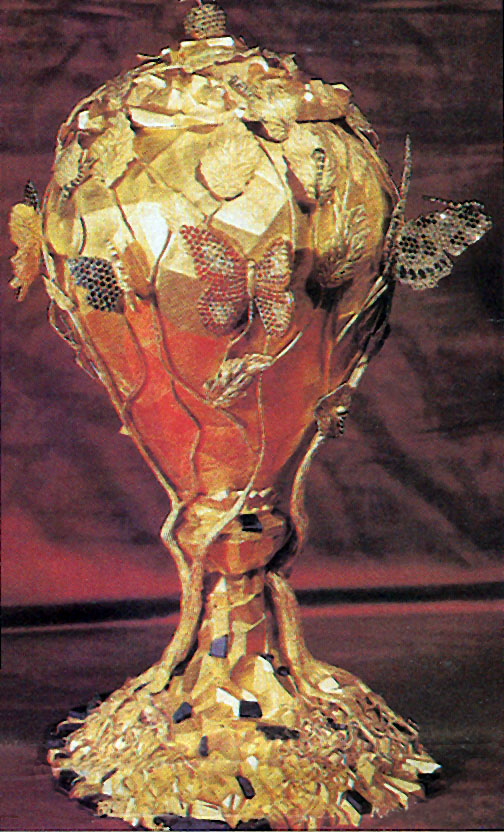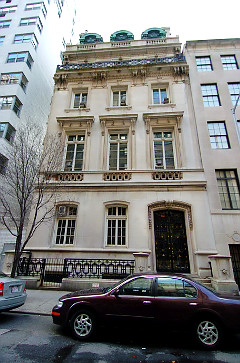|
CHAPTER 14 Rebekah Harkness Builds Her Own Theater Rebekah spent a whopping five million dollars on the job but rumors spread that it had cost a lot more. She had dreamed and planned on making her theater “the first and only major theater in the U.S. specifically designed for dance”, and I do remember for years seeing gigantic and expensive books on theater architecture here and there around Harkness House. The theater’s opening was big news in New York. Some, who were fortunate enough to get a sneak peek before the official opening, claimed the theater had some weird features. The newspapers and magazines could hardly wait. In fact, everyone was anxious to have a look, expecting goodness knows what. Rebekah’s favorite color was blue. I think she had once seen this particular shade of blue on the Maryinsky Theater curtain in Leningrad and liked it. She re-named it ‘Harkness Blue”. At parties and balls she frequently wore a ‘Harkness Blue gown’ and even had a Harkness blue Rolls-Royce, which, regrettably, I never saw. The dishes from the canteen at Harkness House, several of which I managed to keep to this day, are Harkness blue, embossed with a dancing figure in gold. It’s a male dancer reading a book held high above his head with a branch of leaves attached to each foot. What the symbolism is I never managed to discover but the golden H H gives the clue that they belong to Harkness House. Just about everything in the theater was blue. Even the seats in the Dress Circle, salvaged from the old theater, had been painted and re-upholstered in baby blue velvet. The small lobby of black marble (both walls and floors) and I believe six chandeliers, were all designed and imported from Spain. This was because, in addition to her love of blue and her generosity to dance and music, Rebekah had a deep affection for the art, and artists of Spain. I’ve already mentioned in Chapter 11 how she tried desperately to learn Flamenco dancing and brought over the finest teachers from Spain to teach her. She hired a Spanish artist, Enrique Senis-Oliver, to paint a mural for the theater ceiling and this became the talk of the town. Why? Because the dancers he painted up there (Harkness trainees) were all naked. They were portraied in various exotic poses, reaching onwards and upwards to the dance (actually to Rebekah herself, robed in gold as godess of the dance). Some male dancers pictured, and these were trainees I had taught, held candelabras that grew as their own genetalia, with tasteful shading. The mural did have a certain shock value but mostly everyone thought it was in extremely bad taste. Well, that was Rebekah, whose taste in art, music and choreographers may have left a lot to be desired. Senis-Oliver claimed he had spent 3,000 hours lying on his back on a scaffolding while painting this mural in the style of Michelangelo, but unlike Michelangelo, he had the luxury of a TV set and a fridge while he up there. Opening night amounted to virtually the entire New York dance world, plus a good many dancers and choreographers from out of town, even some from Europe that Rebakah flew in at her own expense. The other half of the audience were socialites and their behavior was really awful. All through the evening free champagne was available and as soon as a ballet seemed to be coming to an end they were up and off in search of more bubbly.
The Harkness Ballet Is Finished. Rebakah was of course devastated. She had spared no expense in making her theater a beautiful home for dance in New York. For the opening night she even had yet another face lift! After the dancers returned from the European tour the company was suddenly disbanded. They heroically tried to keep it going, even to begging on the street for contributions but it didn’t work. The theater had a few small plays booked into it but most of the time it was dark. It’s location, a bit away from the Broadway theater district, may have eliminated the potential transient trade. Then, when a musical from South Africa, “Ipi-Tomba” moved in, there were demonstrations. The Socialist Worker’s Party and the Patrice Lamumba Coalition contended the musical showed an unrealistic picture of blacks in South Africa that could be considered pro-apartheid propaganda. Was it all worth it? The theater went up for sale but no one expressed any real interest in buying it. The bear market in the 70s left Rebekah’s finances in a mess and there remained a nasty one million five-hundred yearly deficit. It was all over A liquidation sale of the theater’s furnishings (everything but the walls) was opened for about a month. Admission during the first two days was $2.00 so I went, even though I knew everything would be far above my means. The controversial mural depicting Rebekah surrounded by nude dancers cavorting in various exultant poses was expected to bring in $20,000. I don’t really know if it did. Seats, chandeliers, the counterweight fly system for operating the curtains, plumbing fixtures and other items were hoped to bring in a gross of between $100,000 and $125,000. The theater was torn down in 1975, replaced by a residential building. Only Harkness House remained.My Return To Harkness House David Howard had left and had opened his own successful studio in Manhattan. The new school directors were Nikita Talin and Robert Scevers. “Bobby” Scevers had been, and still was Rebekah’s on and off lover. He was pleasant enough. A very tall man, the trainees jokingly claimed he taught his classes while on stilts! Nikita, who had been a minor dancer with the Ballet Russe de Monte Carlo, enthroned himself in the former library, highly impressed with his own importance. Every time I talked with him he had a cigarette dangling from his mouth with ashes tumbling down his front. They both lived with Rebekah in her penthouse suite at the Carlyle, a few blocks away on Madison Ave. The offices were no longer bugged as they had been but there was still the intrigue going on, the suspicions, the fear of being in one day and out the next at somebody’s whim. Rebekah didn’t care any longer. Occasionally she came in and wandered around as in a daze. The years of drugs and alcohol had taken their toll. Her body, stiff to begin with, was now wracked by pain. She walked like Frankenstein’s monster. I taught ballet and character dance. My character class directly followed the morning hour and a half ballet class, taught by Scevers. That left the trainees exhausted and they really wanted to rest. It was asking too much for them to immediately put in another class of strenuous character dancing. Therefore, my character classes, so loved back at Butler, were almost a chore for them. This was even in spite of a wonderfully inspiring pianist, John Childs, who could play anything I put before him on sight.
The House still had some faded glamour left. Television companies
would rent it for a whole day or even a week to shoot a scene for a
movie or a commercial. It was a beehive of activity every day with
famous people dropping in.
The largest beneficiary of her estate was her dance foundation. After her estate was liquidated it would receive several million dollars. This depended of course on how much was left from the market value of her homes in New York, Palm Beach and Gstaad, Switzerland. I paid my respects standing before the Chalice, placed back on display in the foyer and resumed my classes. I heard that her ashes would not all fit in the chalice and I believe it was eventually sold to a Japanese art dealer. Rebekah Harkness treated many people unfeelingly. Even those who were devoted to her. She was rich, very rich. Whatever her many faults, she shared her enormous wealth with the arts and specifically the dance and I shall always respect her for that. Back from my summer vacation of
two weeks I was suddenly summoned to Nikita’s office (the library)
and told I would not be needed any longer. I had made a lot of money
for the school with full classes and my students liked me.
|



